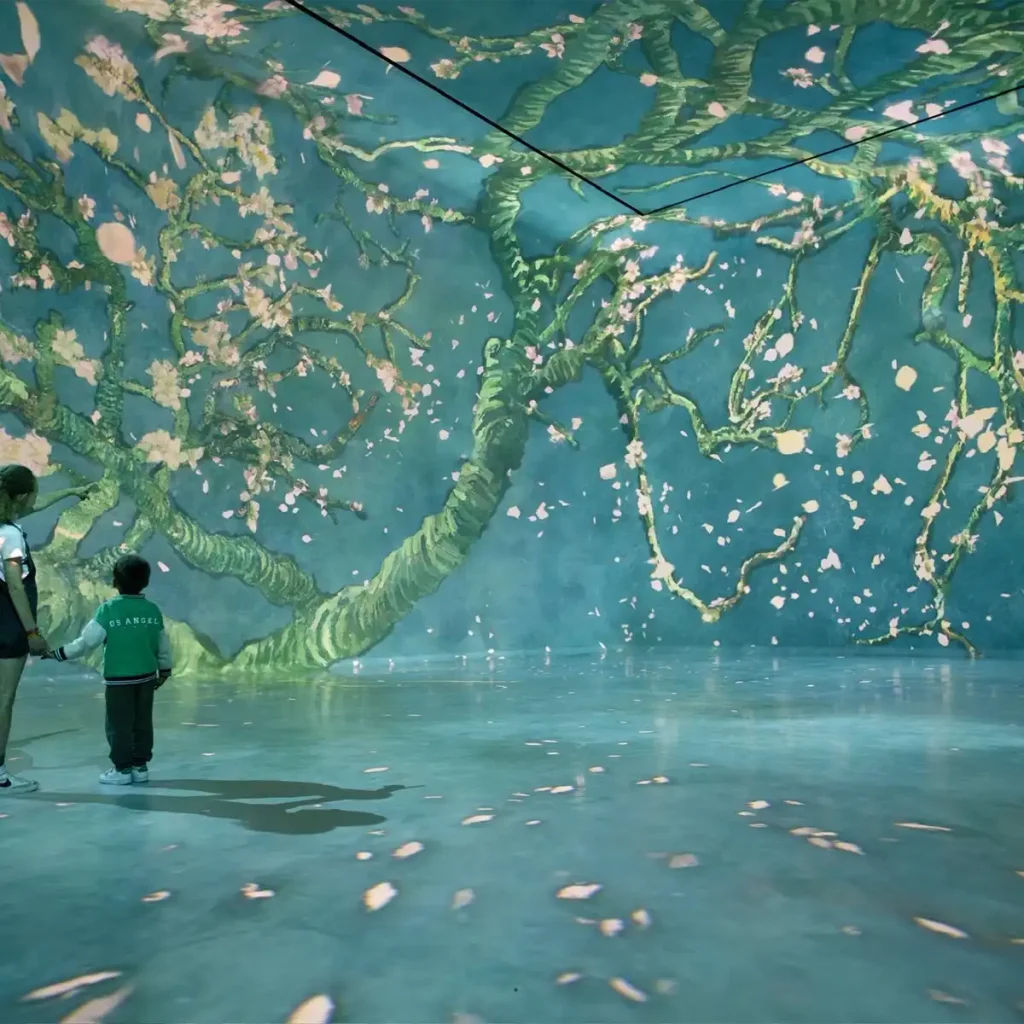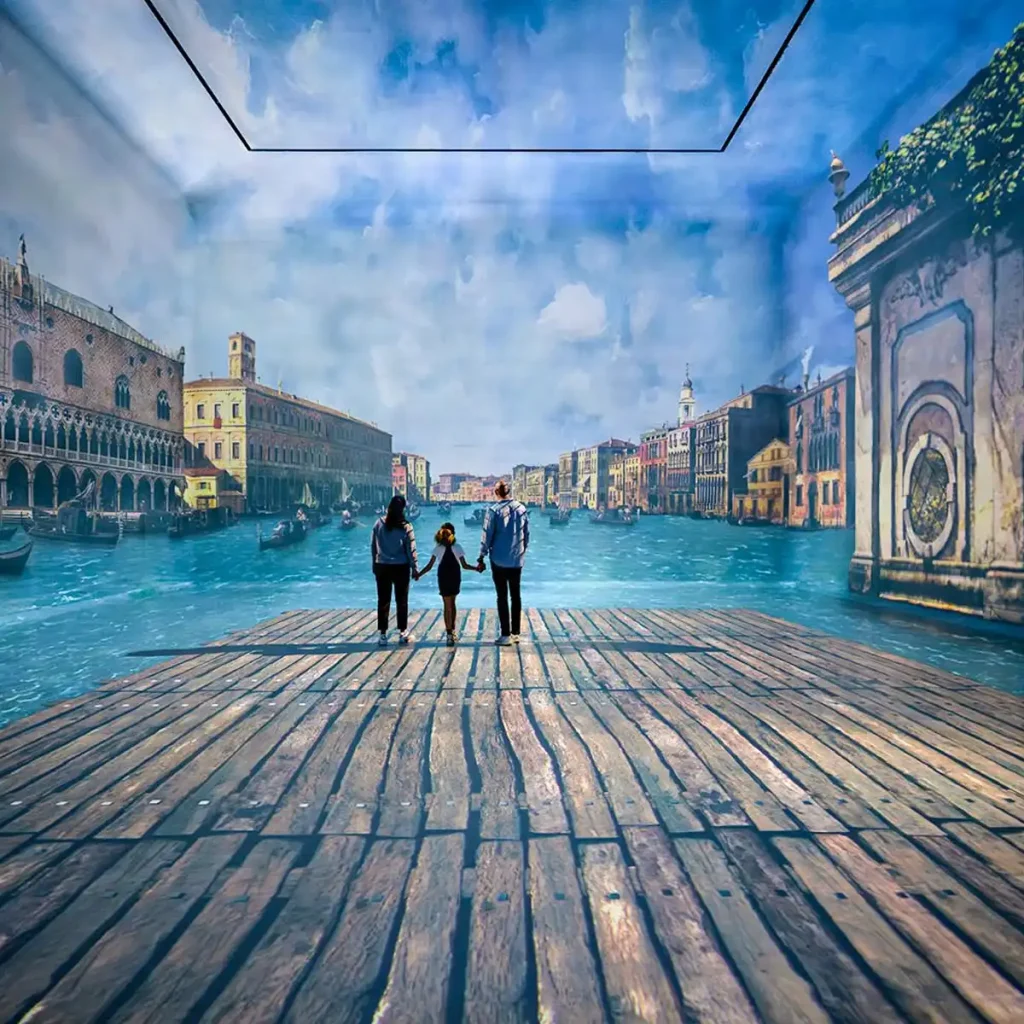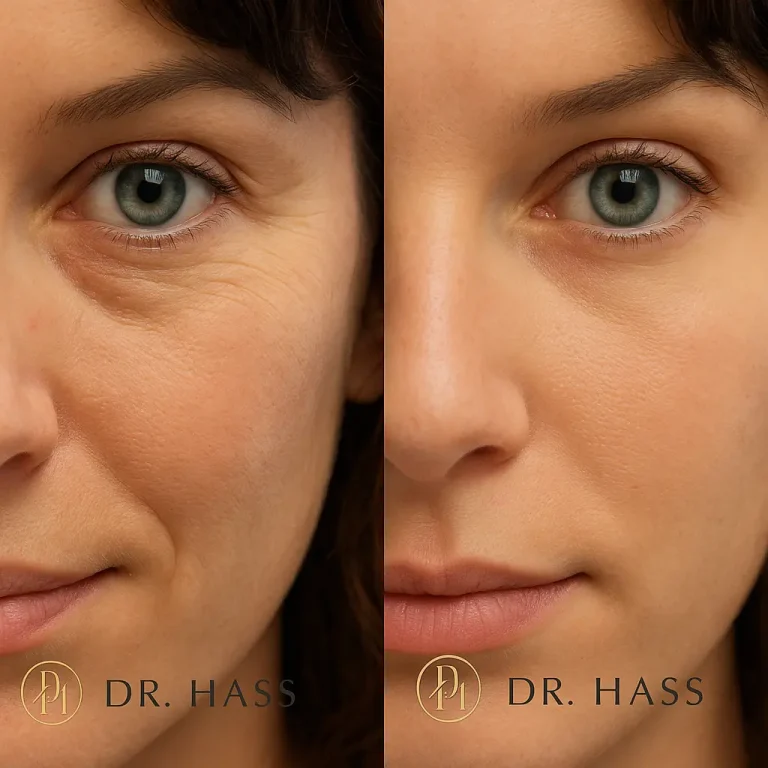Frameless London has become one of the most talked-about cultural attractions in the capital, not because it houses a conventional collection, but because it reframes how audiences encounter art. Opened in October 2022 beneath Marble Arch, the venue occupies around 30,000 square feet and uses high-resolution projection, surround audio and responsive software to turn galleries into enveloping environments. The promise is simple to state and technically complex to deliver. Visitors are invited to step inside celebrated paintings and see them unfold at architectural scale. In 2025, this proposition sits at the intersection of culture, technology and commerce. It also faces clear tests of sustainability, regulation and long-term growth.
The operating company, Frameless London Ltd, is a private limited entity whose filings show a capital-intensive launch, a reduced liability position year on year, and a growing net asset base. The business relies first on ticket revenue shaped by dynamic pricing, supported by on-site hospitality and retail, and reinforced by a B2B channel that includes corporate hire, travel trade sales and a patrons scheme. Above all, management is aiming to evolve from a single venue operator into a creator and licensor of immersive intellectual property. That pivot, embodied by a long-term collaboration with the National Portrait Gallery, will determine whether Frameless becomes a scalable content business rather than a single postcode experience.
Set within Westminster’s tight planning and licensing environment, the venue must balance entertainment value with public safety, neighbourhood impact and data protection law. It has also invested in access. Dedicated sessions for neurodivergent visitors, BSL interpreted tours, and audio-described experiences go beyond compliance and function as a market differentiator. The result is a premium offer that must consistently justify its price while reaching diverse audiences across the week and seasons. What follows sets out how the model works, where the pressure points lie, and what will define success over the next cycle.
Redefines The Art Experience
Frameless is designed around a multi-artist, multi-gallery concept that contrasts with the single-artist blockbuster format that dominated early immersive shows. Across four themed spaces, the venue reinterprets 42 works by 29 artists and synchronises moving images with commissioned and curated sound. The intent is not to replace museum display, but to offer a different mode of engagement for visitors who want scale, motion and narrative cues without object conservation limits.
The decision to present many artists in one visit is strategic. A permanent site with significant fixed costs needs breadth and flexibility. A multi-artist approach widens appeal beyond followers of a single name, spreads licensing and creative risk, and provides modularity for content refresh without a whole venue rebrand. It also allows the team to rebalance the mix as trends shift, preserving relevance across repeat visits.
Layout supports choice. The four headline galleries can be explored non linearly at the visitor’s pace, with a central hub that gives context and orientation. The entry sequence, including a kaleidoscopic escalator, primes expectation before audiences reach the main floors. Academic research on museum wayfinding and perceived agency suggests that self-pacing raises satisfaction and reduces fatigue. In practice, Frameless recommends a 90 to 120 minute dwell, enough to cover all rooms, pause in the hub, and visit the café and shop.
Builds A Hybrid Revenue Engine
Ticket income is the primary lever. Pricing varies by time slot, day, and ticket type, with categories for adults, children and infants, as well as flexible entry and family bundles. Standard adult tickets in 2025 are typically listed in the £20 to £39 range, depending on timing and channel. Bundled family pricing targets the school holiday market and weekend peaks, where conversion is shaped by convenience and perceived value.
Ancillary spend is the second layer. The on-site Café Bar and Gift Shop extend visit duration and capture discretionary spend. Catering operations are delivered with a specialist partner, the Rhubarb Hospitality Collection, which allows Frameless to maintain a premium service level without diluting focus on core content and operations.
B2B completes the stack. Commissionable group rates support tour operators and DMCs. At the same time, the dedicated Blank Canvas space functions as a corporate hire venue and an artist residency room. A patron’s programme invites corporate support with defined benefits. Sponsorships and technology partnerships, notably with Panasonic, create value in cash and kind, and align the attraction with a global manufacturer’s showcase agenda.
The most important future line is IP creation and licensing. The formation of a touring subsidiary and the agreement with the National Portrait Gallery are explicit signals. Suppose the company can produce touring shows that carry respected institutional brands. In that case, it can decouple growth from the physical capacity of Marble Arch and tap international demand for curated, rights-cleared, high-production-value content.
Runs On Advanced Projection And Sound
The technical backbone is extensive. Creative Technology Systems Integration led the delivery of the display, projection and control systems. Panasonic supplies the projectors, positioning the site as a flagship showcase.
The core visual system uses more than 50 Panasonic 3 Chip DLP laser units across the galleries. Flagship models include the PT RQ22K rated at 20,000 lumens with 4K class output via pixel shifting, supported by other high brightness units for floor and ceiling treatment. Ultra short-throw lenses allow projection from concealed mounts at steep angles, which lowers shadowing and keeps hardware out of sight. The combined installation delivers an exceptionally high pixel count and aggregate brightness that makes full room coverage viable at scale.
Playback and synchronisation rely on 19 HIVE Player_3 media servers capable of 4K and 8K delivery. Screen blending and geometry correction are handled by Screenberry software from Front Pictures, which uses camera-based automation for calibration. Interactivity, especially in the Colour In Motion gallery, uses Microsoft Azure Kinect sensors with TouchDesigner to translate movement into live visual change. Audio is distributed through 158 speakers with content that ranges from classical repertoire to original composition.
Fun fact: At full output, the system can deliver around 1 million lumens across the site, which is a useful reference for understanding why floor-to-ceiling projection looks uniform rather than patchy.
For visitors, none of this matters if the experience does not feel coherent. For operators, the stack must be dependable, safe and maintainable with minimal downtime. The partnership with Panasonic, and the use of off-the-shelf but high-performance media servers and software, are designed to balance wow factor with serviceability.
Curates With Licensed Masterpieces And New Works
The content pipeline combines art historical curation and production design. FiveCurrents led overall creative direction, drawing on large-scale live event experience. ArtscapesUK, led by art historian Rose Balston, selected works and shaped narratives across the four themes. The list spans from the Renaissance to modernism. Public domain works allow broad reuse, while modern masters such as Dalí, Mondrian and Klee require licensing from estates or foundations.
Licensing for digital reinterpretation is specialised. Agreements typically define format, term, territories and financial terms. In a permanent venue, these costs recur and must be factored into pricing and refresh cycles. Frameless protects its own outputs through terms of entry and site policies that allow personal photography within limits but prohibit professional capture without permission. This aims to balance visitor sharing with brand and rights management.
The Blank Canvas gallery extends the offer. It operates as a hireable room for events and as a platform for residencies by contemporary digital artists. This keeps the venue connected to current practice and gives returning audiences something new to see beyond the main cycle.


Navigates Westminster Planning And Licensing
Frameless operates at Unit 2, 6 Marble Arch, W1H 7EJ, within the City of Westminster. The company’s SIC code is 91020, museum activities. Positioning within the cultural economy rather than pure leisure aligns the brand with public institutions and can help frame discussions with planners and cultural bodies.
Planning sits within Westminster’s City Plan and the Mayor’s London Plan. As a significant venue in the Central Activities Zone, design, access and neighbourhood impact were central to the original approvals within the Marble Arch Place development. Daily operation is governed by a premises licence under the Licensing Act 2003. Licensable activities include regulated entertainment, the sale of alcohol and late-night refreshment. In this part of Westminster, cumulative impact policy is closely watched. Conditions around service style, hours, capacity and event types aim to protect the licensing objectives on crime and disorder, public safety, public nuisance and child protection. The café service during adults-only evening sessions must therefore operate within clearly defined conditions.
Data protection is handled through a published privacy policy. Personal data collected at purchase or sign-up is used for operations and marketing under legitimate interest, with opt-out controls available. Where data is transferred outside the EEA, the company states that safeguards are applied.
Opens Access With Inclusive Programming
The venue’s access plan goes beyond step-free routes. The building provides level entry and lift access to the basement galleries, and a carer ticket is available free of charge with valid documentation. The programme adds tailored experiences that reduce sensory load and crowding for visitors who need a different environment.
Chilled Sessions, scheduled at regular intervals, lower capacity, reduce volume, soften lighting without full darkness, and switch off loud non-gallery sounds such as hand dryers. A staffed chill-out space provides low light, a dark tent and resources such as ear defenders and fidget tools. The offer extends to BSL interpreted tours for Deaf visitors and audio-described tours for blind and partially sighted visitors, with live narration delivered over headphones.
This is not only a social purpose. It is also an audience strategy. By adapting the core product, Frameless reaches visitors who might otherwise self-exclude from an intense multi-sensory environment. It builds trust among families, schools and community groups, and it supports strong word of mouth among networks that value inclusive design.
Competes In A Crowded Immersive Market
Frameless sits within a London market that now includes several high specification digital venues, each with a distinct model.
Outernet London, located near Tottenham Court Road, is a district featuring LED-wrapped spaces, with its main galleries available for free viewing and monetised through brand partnerships and live venue operations. The format uses huge 16K class LED walls rather than projection, favouring advertising, short-form digital art and launch moments.
Lightroom in King’s Cross is a ticketed projection venue with a focus on single-subject, narrative-led shows developed with headline artists or themes. Early productions included a David Hockney collaboration and a space exploration show narrated by Tom Hanks. Technically, it is close to Frameless, with Panasonic projection and advanced audio, but editorially, it concentrates on deep dives rather than a broad survey.
Moco Museum at 1 Marble Arch is a near neighbour. It is a ticketed contemporary art museum that mixes physical works by figures such as Banksy and Basquiat with digital rooms. It competes for visitors who want contemporary culture with social media-friendly installations.
Within this mix, Frameless positions itself as a premium, ticketed offer that uses projection mapping to assemble a greatest hits of art history across multiple rooms, with a broad family and tourist appeal.
Measures Visitor Impact And Value Perception
From launch, Frameless set a target of more than 750,000 visitors per year. Hitting that figure is central to the financial strategy, given the cost of technology, rent, staff, utilities and licensing. Performance at this level would place Frameless alongside established national attractions that sit between 650,000 and 750,000 annual visits. The comparison underscores ambition and the need for year-round audience generation.
Reviews are mainly positive, with common themes around spectacle, family friendliness, and cross-generational appeal. Price is the most frequent criticism. National press raised concerns about family affordability from the outset, and a share of public reviews describe the experience as expensive relative to duration. The operational challenge is therefore to sustain perceived value while maintaining the premium pricing needed to service the asset base.
Supports Marble Arch Placemaking
Frameless functions as a cultural anchor within Marble Arch Place, replacing a former cinema and helping to reposition the district from thoroughfare to destination. Membership of the Marble Arch London BID links the venue to local safety, environment and promotion programmes funded by the levy. BID reporting in 2024 and 2025 highlighted an uptick in openings across retail and hospitality in the area. While causation is complex, a high-profile attraction with hundreds of thousands of visits has a measurable effect on footfall distribution, dwell time and spend in nearby businesses. The presence of the Moco Museum and proximity to the Wallace Collection contribute to a small cultural cluster that gives visitors reasons to plan multi-site itineraries within walking distance.
Faces Strategic Risks And Opportunities
Strengths include location next to Oxford Street and Hyde Park with strong transport links, a best-in-class technology stack supported by Panasonic, and a multi-artist format that appeals to families, tourists and casual culture seekers. Accessibility programming operates as both a mission and a brand asset.
Weaknesses centre on price sensitivity and the leverage implicit in the accounts. A premium paid experience faces sharper value scrutiny than free large-scale LED environments or subsidised museums. Content refresh requires continuous investment to avoid stasis and to motivate repeat visits.
Opportunities are significant. Touring content and IP licensing can scale beyond the building. Corporate hire and travel trade sales can stabilise weekday utilisation. The patrons programme can broaden support from employers seeking staff benefits and event access.
Threats are real. Competition is intensifying as more venues seek immersive spend. Any downturn in discretionary leisure budgets will hit conversion. There is also the long-term risk that audiences tire of format-driven digital experiences unless the creative layer keeps evolving.
Looks Ahead To Touring IP And Partnerships
The most important development is the strategic move into content creation and licensing. The partnership with the National Portrait Gallery for National Portrait Gallery Unframed begins with Stories Brought To Life, premiering at MediaCity in Salford in May 2025 before touring nationally and internationally. This is a first-order test. If audiences, critics and partners rate the work highly, and if the tour performs financially, Frameless will have demonstrated a model that travels with institutional backing.
Touring offers several advantages. The daily capacity of Marble Arch no longer caps revenue. The business can amortise content costs across multiple venues. Partners gain access to digital engagement formats without building permanent infrastructure. Success here would justify further collaborations with museums and galleries that seek to reach new demographics with trusted collections presented in new ways.
Concluding Assessment
Frameless London has executed a premium immersive offer with serious technology, a clear curatorial concept and a diversified revenue plan. The accounts reveal a high investment start that is normal for a permanent digital venue of this scale, with liabilities reducing as the site trades through and assets embedded in the fit-out. The regulatory context in Westminster is demanding, but the venue has aligned its operations to licence conditions and to data protection standards. The access programme is a strong feature that differentiates the brand and expands audience reach.
The next phase will decide whether Frameless is a successful London attraction or a content company with international reach. In the short term, the test is straightforward. Maintain high visitor numbers, manage value perception in the face of price scrutiny, and prove that refresh cycles and residencies keep the offer current. In the long term, touring content must meet both artistic and commercial benchmarks. Suppose National Portrait Gallery Unframed delivers on both measures. In that case, Frameless will have the foundations to license further titles, open new markets and reduce dependence on a single site.
In other words, the future rests on two levers. Keep London full, and make work that travels. If those levers move together, Frameless can help define how audiences meet art in digital space, and how institutions share collections beyond their walls. As the saying goes, the proof of the pudding is in the eating.




